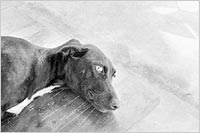|

Browsing
through a selection of past and present photographic works
in the humanist tradition, it seemed to me that representations
of dogs came up with unexpected frequency - not the family
pets or elegant show canines Elliot Erwitt had so much fun
with, but rather those animals living in their own world,
which are encountered just about anywhere outside a few northern
hemisphere cities.
......................
In the last ten or twelve years, it is no longer fashionable
to accuse animal lovers of lavishing their affections on child
substitutes, while the famous photos of Hitler playing with
his dog in Berchtesgaden are no longer seen as off-putting.
It seems that during his Brazilian retirement, Strangl, one-time
commandant of Treblinka concentration camp, is said to have
been struck while gazing at cattle in a slaughterhouse pen
by "these enormous eyes which look at me without knowing
that in a moment, they will die".
The common unity of all living beings has been emphasised
by many philosophers, beginning with Plato who in the Politikos
pointed out that if a distinction is made between humanity
on the one hand and all other living beings on the other,
a similar distinction may come to be applied to humanity itself.
For his part, rather than risk unjustly denying them their
just share of humanity, Rousseau preferred to think of the
great African apes described in travel narratives as distant
cousins, - a position which seems to me fairly close to the
instinctive philosophy of those photographers who are passionate
but cautious observers of life.
One can just as easily encounter among the work of most humanists
past and present the image of a solitary tree. The work of
Marc Trivier from the eighties, combining sequences of trees,
slaughterhouse scenes and portraits of lunatics and of celebrities
from the world of the arts and philosophy with whom he was
in correspondence, probably represents the most radical example
of this approach. Among his correspondents was Gilles Deleuze,
who had long been concerned with the limits of animality.
This perception of the animal takes us back to before what
Levi-Strauss called "the hellish cycle" begun by
Descartes, whom we must hold responsible for the definitive
distinction between human and animal, a distinction which
"serves to separate man from men and to claim, to the
benefit of ever more restricted minorities, the privilege
of a humanity no sooner born than corrupted through having
borrowed its principles and meaning from self-esteem".
The logical culmination of this cycle leads, inevitably, to
the zoological garden1.
............................
Eric Auzoux*
*Excerpted
from My Brother's Image, Photosynkyria 2002, Thessaloniki
Museum of photography. Thessaloniki 2002.
1. Levi-Strauss, Antropologie Structurale, Deux, p.53. Foucault
has demonstrated the parallel evolution of zoos, lunatic asylums
and penitentiaries.
|







